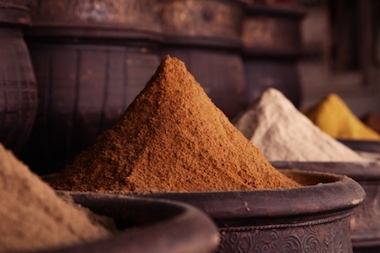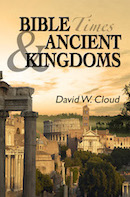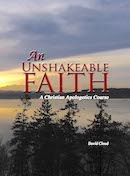866-295-4143, fbns@wayoflife.org

The Song of Solomon mentions spikenard, saffron, calamus, cinnamon, frankincense, myrrh, and aloes (Song 4:14).
From ancient times, the spice trade was worth great amounts of money.
The growing of the rarest spices was centered in southern Arabia (Sheba) and Africa and were transported from there to the spice merchant middlemen such as the Phoenicians, who distributed them across the Mediterranean region (Eze. 27:22). The traffic of spice merchants is also mentioned in 1 Kings 10:15.
The queen of Sheba brought rare spices to Solomon from Arabia (1 Ki. 10:10). Sheba made use of a sophisticated irrigation system with water supplied by a massive dam.
“A gigantic dam blocked the river Adhanat in Sheba, collecting the rainfall from a wide area. The water was then led off in canals for irrigation purposes, which was what gave the land its fertility. Remains of this technical marvel in the shape of walls over 60 feet high still defy the sand-dunes of the desert. Just as Holland is in modern times the Land of Tulips, so Sheba was then the Land of Spices, one vast fairy-like scented garden of the costliest spices in the world. In the midst of it lay the capital, which was called Marib. For 1,500 years this garden of spices bloomed around Marib. That was until [572 AD]--then the dam burst. The importunate desert crept over the fertile lands and destroyed them” (Keller, The Bible as History, p. 225).
The dam that provided water for Sheba’s irrigation system was about a half mile wide and 60 feet high and was “renowned as the greatest of ancient times” (Frank Albright, “The Excavation of the Temple of the Moon at Marib,” Bulletin of the American Schools of Oriental Research, No. 128, Dec. 1952, p. 26).
There were also smaller dams and reservoirs. The area under irrigation is estimated to have been about 72 square kilometers (44 square miles). It was called “the two gardens.”
Ancient Sheba was a beautiful oasis city teeming with palm trees and exotic plants. The kingdom’s wealth increased to such an extent that it became “a byword for riches beyond belief throughout the Arab world” (“Sheba,” The History Files).
Spices for perfume
Wealthy Israelites anointed themselves with ointments made from rare spices (Am. 6:6). David anointed himself with perfumed oil (2 Sa. 12:20). Perfume oils were used in the burial of kings (2 Ch. 16:14).
The Persian rulers used great amounts of spice perfume. They were used in the cosmetic routines in the Persian harems (Est. 2:12). When Alexander the Great defeated Darius’ army at Gaugamela in 331 BC and Darius fled, the Greek conquerer was amazed at what he found when he entered the Persian king’s tent.
“The places, basins, and even the bathtub were all made of gold, while the fragrance of rich perfumes and spices filled the air. The royal Macedonian pages had prepared a banquet for him with captured Persian food and had readied a hot bath” (Freeman, Alexander the Great, p. 120).
The perfumes were blended from expensive spices (called “sweet spices” in Scripture) with the best olive oil as a base. See Exodus 30:34-35.
Making perfume required much skill and was the art of the apothecary (Ex. 37:29). Levites learned the art of the apothecary to blend perfume oils for the temple service (1 Ch. 9:30).
Perfumes were used widely in society, but only the wealthy could afford the rare spices (such as frankincense, myrrh, calamus, and cinnamon).
The process of extracting the spice from the plants was complicated and slow, and only small amounts of fragrance could be extracted from the plants. Some spices were as valuable as silver and gold. Spices and precious ointments were among the treasures that King Hezekiah valued the most (2 Ki. 20:13).
In the Roman Empire, one pound of cinnamon leaves cost six times the average worker’s monthly salary. Rome’s annual trade with India and China for spices cost 10 tons of gold. In that day, a pound of ointment made with spikenard cost 300 denarii (Joh. 12:3-5), which was a full year’s wage for the average worker.
Spices for food, etc.
The ancient spice trade also engaged in food spices. This formed a major part of the famed Silk Road trade during the time of the Persian, Greek, and Roman empires. The most important spices were pepper, cinnamon, ginger, cloves, and nutmeg.
The spices were used for flavoring food, as well as for medicine, making perfume, embalming the dead, preserving meat, and other things.
They grew in the tropical East, notably Indonesia, India, Sri Lanka, and the Moluccas, which were called the Spice Islands. The Moluccas are a chain of Pacific islands between Borneo and New Guinea.
The spices were transported west by ship across the Indian Ocean, up the Red Sea to Egypt, or up the Persian Gulf to Mesopotamia. From there the spices continued the journey west by overland routes or via the Mediterranean Sea. The long journey and the taxes that had to be paid along the way made the spices extremely expensive. Tales were told to hide the source of the spices and to create fear of those places. For example, the Arabs told the Greek historian Herodotus that cassia grew on the shores of a lake and was guarded by huge, vicious birds of prey. According to another legend, the spices were guarded by flying snakes.
After the Romans captured Egypt in the first century BC, they made Alexandria a base to control spice shipments to the west.
For many centuries the Arabs controlled the spice trade.
In the 13th century AD, Venice became the chief middleman for the spice trade with the west. The wealthy city state charged high tariffs, making the spices extremely expensive. A pound of nutmeg in Europe cost seven fattened oxen (“How the Spice Trade Changed the World,” Live Science, May 12, 2008). In AD 300, one pound of ginger in the Roman Empire cost the equivalent of 5,000 days wages of a skilled craftsman (e.g. master mason or carpenter)” (John Munro, “The Luxury Trades of the Silk Road,” Royal Ontario Museum Symposium, Oct. 12, 1983). Today, a pound of ginger cost about 15 minutes wage of a skilled craftsman.
In the late 15th century, at the beginning of the Age of Discovery, European nations funded maritime missions in an attempt to find a direct trade route to the spice islands. When Christopher Columbus’ sailed for the Spanish crown in 1492, he was trying to find a route to India, but he found North America instead. In his confusion, he named the native people of the Bahamas “Indians.”
In 1497, Vasco da Gama of Portugal sailed around Africa to India, opening the way from Europe to the spice lands. This was the beginning of centuries of competition and wars between European nations over the spice trade. The main players were the Portuguese, Spanish, Dutch, and English. “The map of the colonial period was largely drawn in those frenzied years when all of Europe clamored for a piece of the spice trade, using dubious and often brutal tactics to establish a foothold in India and Southeast Asia. Spain and Portugal spent much of the 16th century fighting over cloves, while England and the Dutch dueled over nutmeg in Indonesia” (Live Science, May 12, 2008).
India is still the largest producer of spices in the world. It produces 1.5 million tons a year. The Indian spice business is going high tech, particularly in Bangalore, with machinery replacing hands in grinding and blending. The largest spice company is MDH, founded by Mahashay Dharampal Gulati. Even in his old age (90s), he continues to promote technology and innovation and effective advertising in the spice business. He says, “Life is all about spices.”
- Receive these reports by email
- www.wayoflife.org
______________________
Sharing Policy: Much of our material is available for free, such as the hundreds of articles at the Way of Life web site. Other items we sell to help fund our expensive literature and foreign church planting ministries. Way of Life's content falls into two categories: sharable and non-sharable. Things that we encourage you to share include the audio sermons, O Timothy magazine, FBIS articles, and the free eVideos and free eBooks. You are welcome to make copies of these at your own expense and share them with friends and family. You may also post parts of reports and/or entire reports to websites, blogs, etc as long as you give proper credit (citation). A link to the original report is very much appreciated as the reports are frequently updated and/or expanded. Things we do not want copied and distributed are "Store" items like the Fundamental Baptist Digital Library, print editions of our books, electronic editions of the books that we sell, the videos that we sell, etc. The items have taken years to produce at enormous expense in time and money, and we use the income from sales to help fund the ministry. We trust that your Christian honesty will preserve the integrity of this policy. "For the scripture saith, Thou shalt not muzzle the ox that treadeth out the corn. And, The labourer is worthy of his reward" (1 Timothy 5:18). Questions? support@wayoflife.org
Goal:Distributed by Way of Life Literature Inc., the Fundamental Baptist Information Service is an e-mail posting for Bible-believing Christians. Established in 1974, Way of Life Literature is a fundamental Baptist preaching and publishing ministry based in Bethel Baptist Church, London, Ontario, of which Wilbert Unger is the founding Pastor. Brother Cloud lives in South Asia where he has been a church planting missionary since 1979. Our primary goal with the FBIS is to provide material to assist preachers in the edification and protection of the churches.
Offering: Offerings are welcome if you care to make one. If you have been helped and/or blessed by our material offerings can be mailed or made online with with Visa, Mastercard, Discover, or Paypal. For information see: www.wayoflife.org/about/makeanoffering.html.





